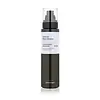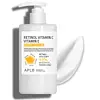What's inside
What's inside
 Key Ingredients
Key Ingredients

 Benefits
Benefits

 Concerns
Concerns

 Ingredients Side-by-side
Ingredients Side-by-side

Water
Skin ConditioningMethylpropanediol
SolventGlycerin
HumectantCaprylic/Capric Triglyceride
Masking1,2-Hexanediol
Skin ConditioningPropanediol
SolventPolyglycerin-3
HumectantNiacinamide
SmoothingPhenyl Trimethicone
Skin ConditioningAmmonium Acryloyldimethyltaurate/Vp Copolymer
Butylene Glycol
HumectantSodium Acrylic Acid/Ma Copolymer
Pentaerythrityl Tetra-Di-T-Butyl Hydroxyhydrocinnamate
AntioxidantXanthan Gum
EmulsifyingMacadamia Ternifolia Seed Oil
EmollientHydrogenated Lecithin
EmulsifyingEthylhexylglycerin
Skin ConditioningAdenosine
Skin ConditioningCarbomer
Emulsion StabilisingDisodium EDTA
Tromethamine
BufferingPolyglyceryl-10 Laurate
Skin ConditioningSodium Hyaluronate
HumectantCholesterol
EmollientTocopherol
AntioxidantBrassica Campestris Sterols
EmollientRetinal
Skin ConditioningAscorbyl Tetraisopalmitate
AntioxidantPotentilla Anserina Extract
Skin ConditioningCaprylyl Glycol
EmollientAluminum/Magnesium Hydroxide Stearate
Emulsion StabilisingPolyquaternium-51
Skin ConditioningCynara Scolymus Leaf Extract
Skin ConditioningAvena Sativa Kernel Extract
AbrasiveBeta-Glucan
Skin ConditioningPotassium Cetyl Phosphate
EmulsifyingCamellia Sinensis Leaf Water
MaskingPiper Methysticum Leaf/Root/Stem Extract
Skin ConditioningSodium Ascorbyl Phosphate
AntioxidantCentella Asiatica Extract
CleansingFicus Carica Fruit Extract
HumectantCeramide NP
Skin ConditioningCentella Asiatica Leaf Extract
Skin ConditioningSaccharomyces Ferment
Skin ConditioningCentella Asiatica Root Extract
Skin ConditioningCanola Oil
EmollientMyristyl Alcohol
EmollientPCA
HumectantAcetyl Hexapeptide-1
Skin ConditioningAsiaticoside
AntioxidantMadecassoside
AntioxidantDaucus Carota Sativa Seed Oil
EmollientBifida Ferment Lysate
Skin ConditioningLactobionic Acid
BufferingDaucus Carota Sativa Root Extract
Skin ConditioningTocopheryl Acetate
AntioxidantBeta-Carotene
Skin ConditioningHelianthus Annuus Seed Oil
EmollientPanthenol
Skin ConditioningPolygonum Cuspidatum Root Extract
AntioxidantSucrose Distearate
EmollientHydroxypropyl Cyclodextrin
MaskingMadecassic Acid
Skin ConditioningAsiatic Acid
Skin ConditioningWater, Methylpropanediol, Glycerin, Caprylic/Capric Triglyceride, 1,2-Hexanediol, Propanediol, Polyglycerin-3, Niacinamide, Phenyl Trimethicone, Ammonium Acryloyldimethyltaurate/Vp Copolymer, Butylene Glycol, Sodium Acrylic Acid/Ma Copolymer, Pentaerythrityl Tetra-Di-T-Butyl Hydroxyhydrocinnamate, Xanthan Gum, Macadamia Ternifolia Seed Oil, Hydrogenated Lecithin, Ethylhexylglycerin, Adenosine, Carbomer, Disodium EDTA, Tromethamine, Polyglyceryl-10 Laurate, Sodium Hyaluronate, Cholesterol, Tocopherol, Brassica Campestris Sterols, Retinal, Ascorbyl Tetraisopalmitate, Potentilla Anserina Extract, Caprylyl Glycol, Aluminum/Magnesium Hydroxide Stearate, Polyquaternium-51, Cynara Scolymus Leaf Extract, Avena Sativa Kernel Extract, Beta-Glucan, Potassium Cetyl Phosphate, Camellia Sinensis Leaf Water, Piper Methysticum Leaf/Root/Stem Extract, Sodium Ascorbyl Phosphate, Centella Asiatica Extract, Ficus Carica Fruit Extract, Ceramide NP, Centella Asiatica Leaf Extract, Saccharomyces Ferment, Centella Asiatica Root Extract, Canola Oil, Myristyl Alcohol, PCA, Acetyl Hexapeptide-1, Asiaticoside, Madecassoside, Daucus Carota Sativa Seed Oil, Bifida Ferment Lysate, Lactobionic Acid, Daucus Carota Sativa Root Extract, Tocopheryl Acetate, Beta-Carotene, Helianthus Annuus Seed Oil, Panthenol, Polygonum Cuspidatum Root Extract, Sucrose Distearate, Hydroxypropyl Cyclodextrin, Madecassic Acid, Asiatic Acid
Water
Skin ConditioningCentella Asiatica Leaf Water
Skin ConditioningGlycerin
HumectantCetyl Ethylhexanoate
EmollientCetearyl Alcohol
EmollientGlyceryl Stearate
EmollientPEG-100 Stearate
Sorbitan Stearate
EmulsifyingCyclopentasiloxane
EmollientSaccharide Hydrolysate
HumectantDimethicone
Emollient1,2-Hexanediol
Skin ConditioningCyclohexasiloxane
EmollientStearic Acid
CleansingChlorphenesin
AntimicrobialCarbomer
Emulsion StabilisingGlyceryl Stearate Se
EmulsifyingCaprylyl Glycol
EmollientXanthan Gum
EmulsifyingPotassium Hydroxide
BufferingDisodium EDTA
Hydroxypropyl Cyclodextrin
MaskingTocopheryl Acetate
AntioxidantButylene Glycol
HumectantAscorbic Acid
AntioxidantDipropylene Glycol
HumectantSqualane
EmollientRetinol
Skin ConditioningAsiaticoside
AntioxidantMadecassic Acid
Skin ConditioningAsiatic Acid
Skin ConditioningSodium Hyaluronate
HumectantMelaleuca Alternifolia Leaf Extract
PerfumingHippophae Rhamnoides Fruit Extract
Skin ConditioningHydrolyzed Collagen
EmollientBeta-Glucan
Skin ConditioningNelumbium Speciosum Flower Extract
Skin ConditioningArtemisia Annua Extract
MaskingOryza Sativa Extract
AbsorbentSaccharomyces Ferment
Skin ConditioningSolanum Melongena Fruit Extract
Skin ConditioningWater, Centella Asiatica Leaf Water, Glycerin, Cetyl Ethylhexanoate, Cetearyl Alcohol, Glyceryl Stearate, PEG-100 Stearate, Sorbitan Stearate, Cyclopentasiloxane, Saccharide Hydrolysate, Dimethicone, 1,2-Hexanediol, Cyclohexasiloxane, Stearic Acid, Chlorphenesin, Carbomer, Glyceryl Stearate Se, Caprylyl Glycol, Xanthan Gum, Potassium Hydroxide, Disodium EDTA, Hydroxypropyl Cyclodextrin, Tocopheryl Acetate, Butylene Glycol, Ascorbic Acid, Dipropylene Glycol, Squalane, Retinol, Asiaticoside, Madecassic Acid, Asiatic Acid, Sodium Hyaluronate, Melaleuca Alternifolia Leaf Extract, Hippophae Rhamnoides Fruit Extract, Hydrolyzed Collagen, Beta-Glucan, Nelumbium Speciosum Flower Extract, Artemisia Annua Extract, Oryza Sativa Extract, Saccharomyces Ferment, Solanum Melongena Fruit Extract
Ingredients Explained
These ingredients are found in both products.
Ingredients higher up in an ingredient list are typically present in a larger amount.
1,2-Hexanediol is a synthetic liquid and another multi-functional powerhouse.
It is a:
- Humectant, drawing moisture into the skin
- Emollient, helping to soften skin
- Solvent, dispersing and stabilizing formulas
- Preservative booster, enhancing the antimicrobial activity of other preservatives
Asiatic Acid is a major component of Centella Asiatica Extract. It has wound-healing, anti-inflammatory, and antioxidant properties.
Studies show Asiatic Acid is able to block the pathway for skin inflammation receptors, helping to soothe skin.
As an antioxidant, asiatic acid helps protect our skin against damaging environmental factors.
Learn more about Asiatic AcidAsiaticoside comes from the super popular skin-soothing ingredient, Centella asiatica. It is one of four active compounds found in the extract of Centella Asiatica.
Asiaticoside is an antioxidant and helps with wound healing. It has been shown to increase antioxidant activity during the wound healing process.
Beta-Glucan is a polysaccharide. It can be derived from the cell walls of seaweed, oats, yeast, and fungi. It hydrates the skin and helps boost your skin's natural barrier.
As an antioxidant, beta-glucan helps fight free-radicals. Free-radicals are molecules that may damage your skin cells, such as pollution.
Studies show this ingredient may be an effective wrinkle reducer as it can deeply penetrate into skin. It has also been show to help with wound healing.
Learn more about Beta-GlucanButylene Glycol (or BG) is used within cosmetic products for a few different reasons:
Overall, Butylene Glycol is a safe and well-rounded ingredient that works well with other ingredients.
Though this ingredient works well with most skin types, some people with sensitive skin may experience a reaction such as allergic rashes, closed comedones, or itchiness.
Learn more about Butylene GlycolCaprylyl Glycol is a humectant and emollient, meaning it attracts and preserves moisture.
It is a common ingredient in many products, especially those designed to hydrate skin. The primary benefits are retaining moisture, skin softening, and promoting a healthy skin barrier.
Though Caprylyl Glycol is an alcohol derived from fatty acids, it is not the kind that can dry out skin.
This ingredient is also used as a preservative to extend the life of products. It has slight antimicrobial properties.
Learn more about Caprylyl GlycolCarbomer is a polymer of acrylic acid. Its main role is to create a gel consistency.
A high amount of carbomer can cause pilling or balling up of products. Don't worry, most products contain 1% or less of carbomer.
Disodium EDTA plays a role in making products more stable by aiding other preservatives.
It is a chelating agent, meaning it neutralizes metal ions that may be found in a product.
Disodium EDTA is a salt of edetic acid and is found to be safe in cosmetic ingredients.
Learn more about Disodium EDTAGlycerin is already naturally found in your skin. It helps moisturize and protect your skin.
A study from 2016 found glycerin to be more effective as a humectant than AHAs and hyaluronic acid.
As a humectant, it helps the skin stay hydrated by pulling moisture to your skin. The low molecular weight of glycerin allows it to pull moisture into the deeper layers of your skin.
Hydrated skin improves your skin barrier; Your skin barrier helps protect against irritants and bacteria.
Glycerin has also been found to have antimicrobial and antiviral properties. Due to these properties, glycerin is often used in wound and burn treatments.
In cosmetics, glycerin is usually derived from plants such as soybean or palm. However, it can also be sourced from animals, such as tallow or animal fat.
This ingredient is organic, colorless, odorless, and non-toxic.
Glycerin is the name for this ingredient in American English. British English uses Glycerol/Glycerine.
Learn more about GlycerinThis ingredient is used in skincare as a delivery system.
It works by "encapsulating" active ingredients with its unique ring shape that is water-loving on the outside and oil-loving on the inside. This improves the stability and absorption of the product into the skin.
According to a manufacturer, it also offer some moisturizing effects.
Learn more about Hydroxypropyl CyclodextrinMadecassic Acid is a major component of Centella Asiatica Extract. It has anti-inflammatory and antioxidant properties.
It is a triterpenoid, meaning it naturally acts as an antioxidant. Antioxidants protect your skin against damage from environmental factors such as pollution and UV.
Studies show Madecassic Acid helps soothe the skin due to its ability to block inflammation pathways.
Learn more about Madecassic AcidSaccharomyces Ferment is created from fermenting and filtering saccharomyces, a group of fungus that includes yeasts. It is a humectant and helps hydrate the skin.
This ingredient contains amino acids, beta-glucan, and vitamins. Beta-glucan is a potent antioxidant and may help with the signs of aging.
This ingredient may not be fungal-acne safe.
Learn more about Saccharomyces FermentSodium Hyaluronate is hyaluronic acid's salt form. It is commonly derived from the sodium salt of hyaluronic acid.
Like hyaluronic acid, it is great at holding water and acts as a humectant. This makes it a great skin hydrating ingredient.
Sodium Hyaluronate is naturally occurring in our bodies and is mostly found in eye fluid and joints.
These are some other common types of Hyaluronic Acid:
Learn more about Sodium HyaluronateTocopheryl Acetate is AKA Vitamin E. It is an antioxidant and protects your skin from free radicals. Free radicals damage the skin by breaking down collagen.
One study found using Tocopheryl Acetate with Vitamin C decreased the number of sunburned cells.
Tocopheryl Acetate is commonly found in both skincare and dietary supplements.
Learn more about Tocopheryl AcetateWater. It's the most common cosmetic ingredient of all. You'll usually see it at the top of ingredient lists, meaning that it makes up the largest part of the product.
So why is it so popular? Water most often acts as a solvent - this means that it helps dissolve other ingredients into the formulation.
You'll also recognize water as that liquid we all need to stay alive. If you see this, drink a glass of water. Stay hydrated!
Learn more about WaterXanthan gum is used as a stabilizer and thickener within cosmetic products. It helps give products a sticky, thick feeling - preventing them from being too runny.
On the technical side of things, xanthan gum is a polysaccharide - a combination consisting of multiple sugar molecules bonded together.
Xanthan gum is a pretty common and great ingredient. It is a natural, non-toxic, non-irritating ingredient that is also commonly used in food products.
Learn more about Xanthan Gum